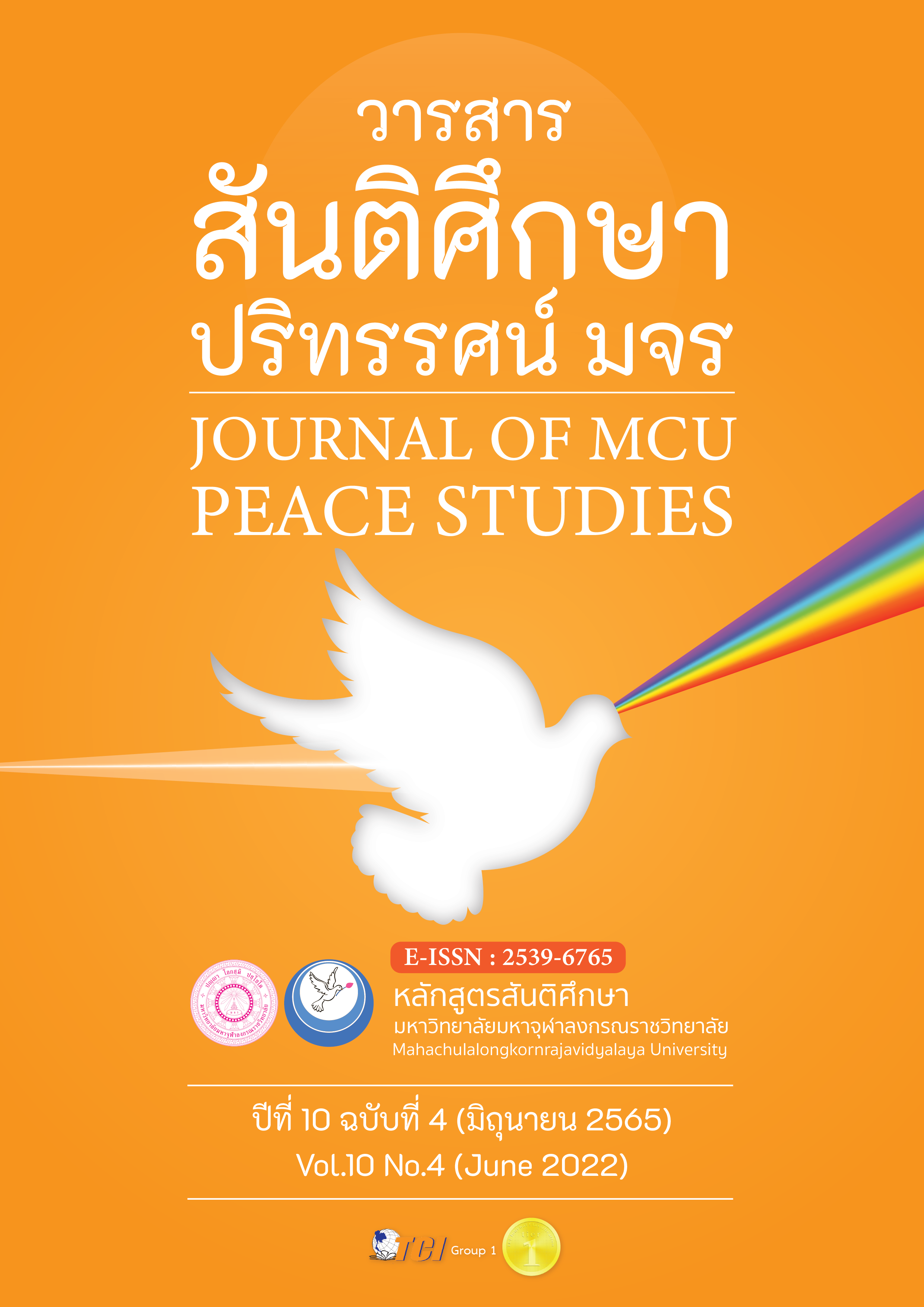การวิเคราะห์องค์ประกอบเชิงยืนยันสมรรถนะด้านตรรกวิทยา และความมีเหตุผลสำหรับเด็กปฐมวัย
Main Article Content
บทคัดย่อ
บทความวิจัยนี้ มีวัตถุประสงค์เพื่อวิเคราะห์องค์ประกอบเชิงยืนยันสมรรถนะด้านตรรกวิทยาและความมีเหตุผลสำหรับเด็กปฐมวัย การวิจัยนี้เป็นการรวบรวมข้อมูลเชิงปริมาณ กลุ่มตัวอย่างที่ใช้ในการศึกษาคือ ครูผู้สอนปฐมวัย โดยผู้วิจัยใช้เกณฑ์ของการกำหนดกลุ่มตัวอย่าง คือ ขนาดกลุ่มตัวอย่างเท่ากับ 20 เท่า ต่อตัวแปรที่สังเกตได้ 1 ตัวแปร โดยในงานวิจัยมีตัวแปรที่ศึกษาทั้งหมด 3 องค์ประกอบ 15 ตัวแปรสังเกตได้ ดังนั้นจึงกำหนดขนาดกลุ่มตัวอย่างจริง 360 คน เครื่องมือที่ใช้ในการเก็บข้อมูลเป็นแบบสอบถามมี ค่าดัชนีความสอดคล้อง 0.06 – 1.00 และความเชื่อมั่นของแบบสอบถามโดยใช้วิธีสัมประสิทธิ์แอลฟ่าของครอนบาค มีค่าระดับความเชื่อมั่นเท่ากับ 0.937 แสดงว่าเครื่องมือมีความเชื่อมั่น และความเที่ยงตรงระดับดี
ผลการศึกษาวิจัยพบว่า สมรรถนะด้านตรรกวิทยาและความมีเหตุผลประกอบด้วย 3 องค์ประกอบ ได้แก่ ด้านความสามารถการใช้เหตุผลเชิงตรรกะ ด้านความสามารถการคิดแก้ปัญหาและการตัดสินใจเชิงตรรกะ ด้านความสามารถการคิดรวบยอดเชิงตรรกะ ผลการวิเคราะห์องค์ประกอบเชิงยืนยันของโมเดลสมรรถนะด้านตรรกวิทยาและความมีเหตุผลสำหรับเด็กปฐมวัย มีความสอดคล้องกับข้อมูลเชิงประจักษ์ X2/df เท่ากับ GFI = 0.917, AGFI = 0.902, CFI = 1.00, RMSEA = 0.025 แสดงว่าโมเดลที่พัฒนาขึ้นสามารถนำมาอธิบายสมรรถนะด้านตรรกวิทยาและความมีเหตุผลได้ และสอดคล้องกับข้อมูลเชิงประจักษ์
Article Details

อนุญาตภายใต้เงื่อนไข Creative Commons Attribution-NonCommercial-NoDerivatives 4.0 International License.
ทัศนะและความคิดเห็นที่ปรากฏในบทความในวารสาร ถือเป็นความรับผิดชอบของผู้เขียนบทความนั้น และไม่ถือเป็นทัศนะและความรับผิดชอบของกองบรรณาธิการ ยินยอมว่าบทความเป็นลิขสิทธิ์ของวารสาร
เอกสารอ้างอิง
Academic and Research Support Group Office of Health Promotion, Department of Health. (2017). The study report the 6th of factors effecting to child development in Thailand in 2017. Bangkok: Academic and Research Support Group Office of Health Promotion, Department of Health.
Bollen, K. A. (1989). Structural equations with latent variables. New York: John Wiley & Sons.
Browne, M. W., & Cudeck, R. (1993). Alternative ways of assessing model fit, in Testing Structural Equation Models, ed. Newbury Park CA: Sage.
Bruner, J. (1963). The Process of Education. New York: Alfred A. Knopf and Random House.
Diamantopoulos, A., & Siguaw, A. D. (2000). Introducing LISREL: A guide for the uninitiated. London: Sage Publications.
Gagne, R. M. (1985). The Conditions of Learning and Theory of Instruction. Japan: CBS College.
Hair, et al. (2006). Multivariate data analysis. (7th ed.). New Jersey: Pearson Education International.
Kaosim, J. et al. (2021). The Development of Problem Solving Ability of the Early Childhood Student by Cooperative Art Activities Feature though the Story Telling. Neu Academic and Research Journal, 11(1), 1–13.
Khammani, T. (2017). Science of Teaching Pedagory: Knowledge of organizing effective learning processes. (21st ed.). Bangkok: Chulalongkorn University.
Klangphahol, K. (2018). Research Methodology in Education. Pathum Thani: Faculty of Education, Valaya Alongkorn Rajabhat University under the Royal Patronage.
McClelland, D. C. (1973). Testing for competence rather than intelligence. American Psychologist, 28(1), 1-14.
Meesomsarn, K. (2017). Educational Management and Curriculum for Early Childhood Vol. 2. Nonthaburi: School of Educational Studies, Sukhothai Thammathirat Open University.
Ministry of Education. (2017). Early Childhood Education Program, B.E. 2560. Bangkok: Agricultural Co-Operative Federation of Thailand Ltd.
Mueller, R. O. (1996). Basic Principles of Structural Equation Modeling. An Introduction to LISREL and EQS. New York: Springer-Verlag.
Nunnally, J. (1967). Psychometric theory. New York: McGraw-Hill.
Office of the Education Council the United Nations Children’s Fund (Thailand). (2017). The behavior of the children in the sample group was classified according to the performance of early childhood children according to the quartile level and classified by age group of children 3-5 years. Bangkok: Prigwhangraftfic Co. Ltd.
Office of the Education Council, Ministry of Education. (2019). the Approaches to developing student competency at basic education level. Bangkok: 21st Century Co. Ltd.
Office of the National Economic and Social Development Council. (2017). National Economic and Social Development Plan No. 12 (B.E. 2560-2564). Bangkok: Office of the National Economic and Social Development Council.
Piaget, J. (1970). Science of Education and the Psychology of the Child. New York: Orion Press.
Sakong, M., Suwankitti, S., & Niyomsap, N. (2021). Development of Conceptual and Logical Thinking in Kindergarten 3 Students Using Conceptual Learning Management Together with Graphic Diagram Technique. Journal for Social Sciences Research, 12(1), 149-169.
Sorbon, D. (1996). LISREL 8: User's Reference Guide. Sweden: Scientific Software International.
Suksawang, P. (2013). Structural equation modeling. Bankok: Watanapanich Co. Ltd.


